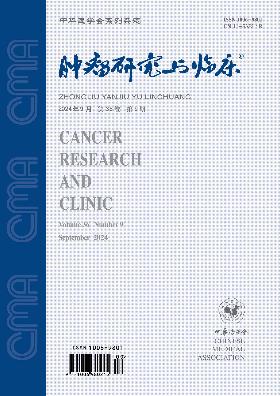人线粒体转录终止因子3和叉头盒蛋白3对癌症预后的预测价值
Q4 Medicine
引用次数: 0
摘要
目的探讨人线粒体转录终止因子3 (hMTERF3)和叉头盒蛋白3 (Foxp3)在非小细胞肺癌(NSCLC)中的预后价值。方法回顾性分析解放军总医院第三医疗中心2017年3月至2018年3月收治的88例非小细胞肺癌患者的临床资料。所有患者均经病理穿刺诊断。电话随访12个月,根据预后情况分为预后好组和预后差组。所有患者均取病理组织,免疫组化检测hMTERF3、Foxp3蛋白表达。比较预后良好组和预后不良组hMTERF3、Foxp3的表达情况。采用Logistic回归模型分析非小细胞肺癌患者预后不良的危险因素。结果88例患者中,预后良好61例(69.3%),预后不良27例(30.7%)。预后良好组hMTERF3阳性表达率为57.4%(35/61),显著低于预后不良组81.5% (22/27)(χ 2= 4.766, P= 0.029)。预后良好组Foxp3阳性表达率为55.7%(34/61),显著低于预后不良组85.2% (23/27)(χ 2= 7.113, P= 0.008)。预后良好组中、高分化或分期Ⅰ-Ⅱ的患者比例分别为82.0%(50/61)和68.8%(42/61),显著高于预后差组48.15%(13/27)和25.93%(7/27),差异均有统计学意义(P < 0.05)。Logistic回归分析显示分化不良、分期Ⅲ-Ⅳ、hmterf3阳性、foxp3阳性是NSCLC患者预后不良的危险因素(均P < 0.05)。结论hMTERF3和Foxp3在预后较好的患者中阳性表达率较低。hmterf3阳性和foxp3阳性是NSCLC患者预后不良的危险因素。关键词:肺癌,非小细胞肺;线粒体蛋白质;叉头转录因子;人线粒体转录终止因子3;叉头盒蛋白3;预后本文章由计算机程序翻译,如有差异,请以英文原文为准。
Value of human mitochondrial transcription termination factor 3 and forkhead box protein 3 in predicting the prognosis of non-small cell lung cancer
Objective
To explore the prognostic value of human mitochondrial transcription termination factor 3 (hMTERF3) and forkhead box protein 3 (Foxp3) in non-small cell lung cancer (NSCLC).
Methods
The clinical data of 88 patients with NSCLC who were admitted to the Third Medical Center of PLA General Hospital from March 2017 to March 2018 were retrospectively analyzed. All patients were diagnosed by pathological puncture. The patients were followed-up by telephone for 12 months, and according to the prognosis, the patients were divided into good prognosis group and poor prognosis group. The pathological tissues were taken from all patients, and the expressions of hMTERF3 and Foxp3 proteins were detected by immunohistochemistry. The expressions of hMTERF3 and Foxp3 in the good prognosis group and the poor prognosis group were compared. Logistic regression model was used to analyze the risk factors of poor prognosis in patients with NSCLC.
Results
Of 88 patients, 61 patients (69.3%) had good prognosis and 27 patients (30.7%) had poor prognosis. The positive expression rate of hMTERF3 in the good prognosis group was 57.4% (35/61), which was significantly lower than that in the poor prognosis group (81.5%, 22/27) (χ 2= 4.766, P= 0.029). The positive expression rate of Foxp3 in the good prognosis group was 55.7% (34/61), which was significantly lower than that in the poor prognosis group (85.2%, 23/27) (χ 2= 7.113, P= 0.008). The proportions of patients with medium and high differentiation or stage Ⅰ- Ⅱ in the good prognosis group were 82.0% (50/61) and 68.8% (42/61), respectively, which were significantly higher than those in the poor prognosis group [48.15% (13/27) and 25.93% (7/27)] (both P < 0.05). Logistic regression analysis showed that the poor differentiation, stage Ⅲ-Ⅳ, hMTERF3-positive and Foxp3-positive were the risk factors for poor prognosis in NSCLC patients (all P < 0.05).
Conclusions
The positive expression rates of hMTERF3 and Foxp3 in patients with good prognosis are lower. The hMTERF3-positive and Foxp3-positive are risk factors for poor prognosis in NSCLC patients.
Key words:
Carcinoma, non-small-cell lung; Mitochondrial proteins; Forkhead transcription factors; Human mitochondrial transcription termination factor 3; Forkhead box protein 3; Prognosis
求助全文
通过发布文献求助,成功后即可免费获取论文全文。
去求助
来源期刊

肿瘤研究与临床
Medicine-Oncology
CiteScore
0.10
自引率
0.00%
发文量
7737
期刊介绍:
"Cancer Research and Clinic" is a series of magazines of the Chinese Medical Association under the supervision of the National Health Commission and sponsored by the Chinese Medical Association.
It mainly reflects scientific research results and academic trends in the field of malignant tumors. The main columns include monographs, guidelines and consensus, standards and norms, treatises, short treatises, survey reports, reviews, clinical pathology (case) discussions, case reports, etc. The readers are middle- and senior-level medical staff engaged in basic research and clinical work on malignant tumors.
 求助内容:
求助内容: 应助结果提醒方式:
应助结果提醒方式:


